New mats keep the mess out of the MU
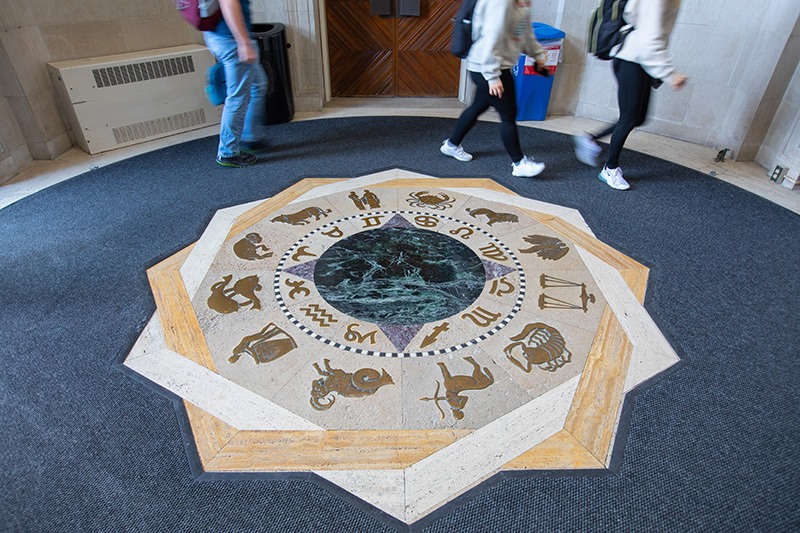
Students walk on a custom shaped mat that surrounds the zodiac in an entryway to the Memorial Union. Photo by Christopher Gannon.
Faculty, staff students and guests entered the Memorial Union (MU) approximately 1.26 million times in 2022. They had books, backpacks and coats, but more than anything, their shoes carried in 1,259 pounds of dirt the custodial staff had to remove.
MU custodial services manager George Loper went to work to clean up the situation, not by tasking his crews with additional hours of sweeping and vacuuming, but by improving the matting system at the entrances. It included a custom mat around the zodiac and a runner to help set off Gold Star Hall.
"We don't have to take dirt out that we don't let into the building," Loper said. "The mats are a solution to more cleaning, which was time consuming."
Replacing the old mats with higher quality ones means custodians went from cleaning a 15-foot area around the mats to three or four feet, Loper said. The 16 mats arrived in April for six entrances -- north, east, south, west, in the basement and the back ramp -- and four runners in front of the elevator or high-traffic areas. The early results are promising, but Loper and his staff know that the big test arrives with winter.
"When winter came around last year, the custodians put a lot of work into the floor, whether they scrubbed and coated them, or scrubbed, stripped and waxed them," he said.
The numbers
An MU study found 3.45 pounds of dirt entered the building each day. To remove one pound costs approximately $500-$600 in labor, equaling $2,070 a day. The new mats -- which have a life of seven to 10 years -- cut the amount of dirt that makes it past the entrance by 70%. The new mats save an average of $1,452 a day in operating costs or $91,841 a year. Over the next seven years, savings reach $642,000.
Loper worked with Mats Inc. of St. Louis to research and place the proper mats.
Protecting the MU
The MU has a two-mat system at each entry. A wiper/scraper mat in the entryway captures larger dirt particles and moisture from shoes. After an individual passes through a second set of doors, an interior wiper mat removes any remaining dirt and moisture. The overall use of each entrance decides the length and size of a mat.
Loper's team measured each entrance and installed mats of various lengths. The goal is to have at least 15 feet, but most entrances have more. The American Institute of Architects reported that five feet of mat captures 33% of walked-in debris, 10 feet collects 52% and 20-25 feet captures as much as 100% of what's on the bottom of shoes.
The mats have strong rubber backing and more effective bristles than their predecessors which keeps them from slipping. They promote safety and are more pleasing to look at. Ensuring the new mats did not change the look of the MU was important since the building contains some of the most notable features across campus, Loper said.
"We were always concerned with the look of each mat because there is a lot more at stake than the custodial division benefiting from mats," he added.
Loper credits his staff for making the new mats a reality. They took on additional work for six months, postponing the need for additional custodians. The money saved paid for the mats.
"Prior to getting the new mats it really seemed like a never-ending battle to keep any kind of debris out of the building," said MU custodian Derek Bjelland. "I think it makes a huge difference."
Instead of scrubbing and cleaning mats several times a day, custodial staff vacuum once every other day, and the hard rubber back allows for them to be turned, swept and put back. The time saved allows custodians to focus on other aspects of their work.
Terrazzo floor finish
To further protect the MU floors, the custodial staff is restoring the original 1923 trazel coating on the terrazzo flooring. It will eliminate future stripping or waxing, Loper said. The process, which prevents anything from sticking to the floor, is complete at the north entrance and around the M-Shop west entrance, with staff preparing to move to the second and third floors.
Wintersteen accepts committee's Catt Hall recommendation
A review committee, after its final vote, has recommended the university keep the name of Carrie Chapman Catt on Catt Hall.
In a campus message this morning to students, faculty and staff, President Wendy Wintersteen accepted the committee's recommendation and thanked members for their service, which began in the spring of 2021.
"The committee has methodically dealt with an extremely complicated task," Wintersteen said. "The committee members had to come to grips with history that is told and understood from differing perspectives across a century. Theirs was an extraordinary commitment of time and effort. With thoughtful consideration of factual and historical materials, the committee deeply examined an important and complex historical figure."
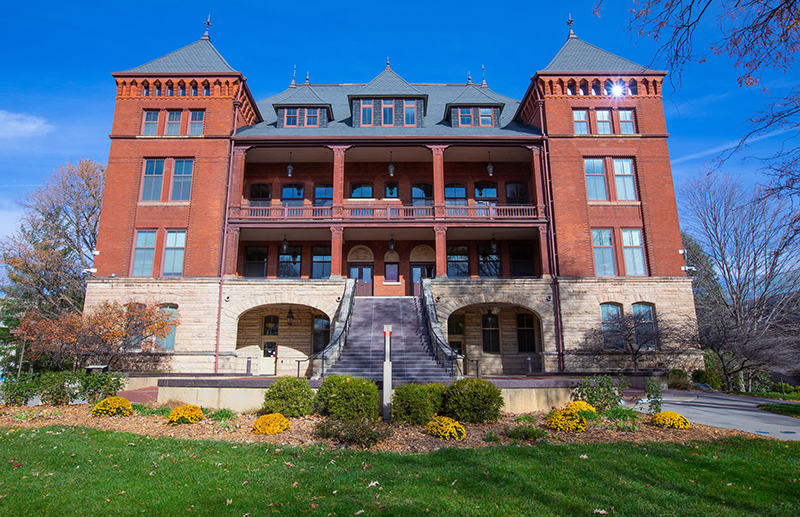
Carrie Chapman Catt Hall.
The review committee took its final vote on Nov. 3 -- its 28th meeting. Eleven members voted to keep the name of Catt Hall, and four members voted to remove the name. As outlined in the university policy, two-thirds of the committee members must agree to recommend a name removal. A recommendation to remove the name would have required a final decision by the state Board of Regents under its own naming policy. However, because the recommendation is to keep the name, no further action is required.
In the committee's initial vote held in August, nine members voted to keep the name and six voted to remove. Following that initial vote, a 60-day public comment period began, ending Oct. 29. Over the two months, 311 comments were submitted to the committee. A link to all public comments reviewed by the committee is included in the appendix of the final report.
"I appreciate those who took the time to read the committee's report and provide thoughtful feedback," said Carol Faber, chair of the committee. "The number of individuals who responded underscores the importance of this issue to the university community, our alumni and stakeholders, and the public."
The committee reviewed nearly 250 historical documents from libraries, archives and databases around the country, and interviewed 12 persons with knowledge and expertise on Catt and events surrounding the building's naming.
"Equipped with these excellent resources and feedback, the committee engaged in an earnest, well-informed discussion and arrived at this report and recommendation," Faber said. "I thank the committee members for their patience and commitment. It is serious business to develop a recommendation to keep or remove a name on university property, and the committee gave the task thoughtful consideration and careful analysis."
As outlined in the policy and procedures, the committee will provide materials from the Catt Hall review to the library's Special Collections and University Archives to preserve and make available for public access.
Among Catt's connections to Iowa State during her lifetime, as outlined in the committee's report, were as a student, enrolling in 1877; an alumna, graduating in 1880; a recipient of an honorary Doctor of Laws degree in 1921; a commencement speaker in both 1921 and 1930; and, upon her death in 1947, a donor.
Catt succeeded Susan B. Anthony as president of the National American Woman Suffrage Association, serving from 1900 to 1904 and from 1915 to 1920. She led the effort that culminated in the ratification of the 19th Amendment to the Constitution in 1920, giving American women the right to vote.
Related stories
- Initial vote supports Catt's name on building, Aug. 31, 2023
- Research continues for committee considering Catt Hall name, Oct. 20, 2022
- Review committee delves into Catt files, Sept. 23, 2021
- Work begins to review the naming of Catt Hall, May 6, 2021
Welcome

ISU Dining director Karen Rodekamp. Photo by Christopher Gannon.
Karen Rodekamp, associate director for engagement in ISU Dining, has been promoted to director of ISU Dining, effective Nov. 1. She had served in the position on an interim basis since late September.
With the residence department and the Memorial Union, ISU Dining is part of the campus life unit in the division of student affairs.
Rodekamp has worked for the university's campus dining services in a variety of responsibilities since 1999, when she started as an assistant manager for catering and later led the Memorial Union catering unit. In 2005, she transferred to dining's food stores, where she purchased produce and commodities for 25-plus production and service locations across campus. She later moved to the business and support services office, which involved more duties in contract management and sustainability initiatives. She was promoted to associate director for engagement in 2019. The engagement role has oversight for educating students and families about meal plan and dietary service options, the student staffing and nutritional support units, and special events, working closely with the marketing team. For a time, Rodekamp will continue to handle responsibilities related to this leadership post.
Rodekamp previously served as an interim codirector of ISU Dining for much of 2022.
Her real start in campus dining occurred during her undergraduate years at Iowa State. She worked as a student employee and student manager while earning a bachelor's degree in hotel, restaurant and institutional management.
Rodekamp's office is in 1215 Friley. She can be reached by phone at 515-294-1486, by email at kschmit@iastate.edu.
Operations/finance leadership team is set
Senior vice president for operations and finance Shawn Norman recently announced to the division's employees that several leadership searches were completed.
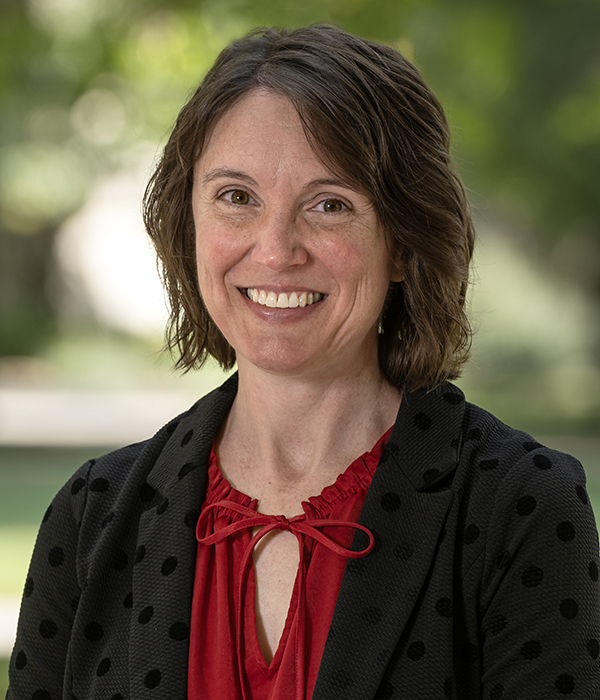
Kisch
Wendy Kisch, who had served as interim associate vice president for facilities planning and management (FPM) since July 1, was named to the post on a permanent basis.
Kisch has been with Iowa State since 2011, serving the division of operations and finance in multiple roles, including assistant director of facilities services. From 2021 to this summer, she served as director of operations for the Student Innovation Center.
Kisch completed a bachelor's degree in industrial engineering and a master's degree in statistics, both from Iowa State.

Latterell
Brandi Latterell is the division's inaugural assistant vice president for real estate and capital planning.
Latterell has been with Iowa State since 1997 and held multiple roles within FPM. Most recently she served as director for planning services, where she was responsible for developing the university's five-year capital plan and executing its real estate acquisition strategy.
Latterell earned a bachelor's degree in interior design from Iowa State.
Kisch and Latterell's appointments began Oct. 30.
Division review
In August, following a monthslong assessment of the division by a consultant team, Norman tweaked the leadership structure and changed the reporting line for some units to strengthen how units work together to serve the university community. In this summer's cost-neutral realignment, he worked with university human resources to create two new assistant vice president positions, overseeing real estate and capital planning, and operations and strategy, respectively.
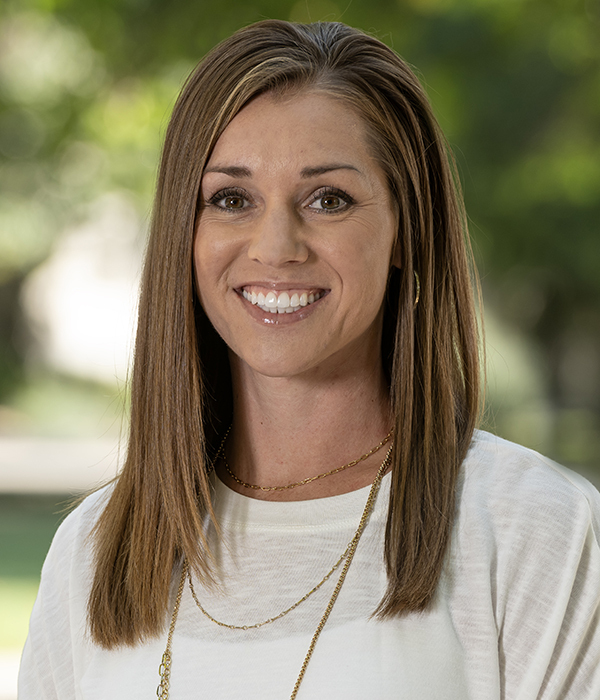
Dillon
Kristi Dillon began serving in that second assistant VP post on Sept. 29.
Dillon has worked at Iowa State for more than 12 years, serving in the accounts receivable office and the business operations side of recreation services. Before she was named to the operations and strategy post, she served as senior manager of budget and finance for information technology services.
Dillon earned a bachelor's degree in public health education and promotion from the University of Northern Iowa and an MBA with an emphasis in management and organizations from the University of Iowa.
Diversity recommendations, faculty development requests on next week's regents agenda
Faculty professional development assignment requests for next year and the schematic design for a $66.5 million phase two of the Veterinary Diagnostic Laboratory (VDL) are on the agenda when the state Board of Regents meets Nov. 15-16 at the University of Northern Iowa. Additionally, the three-regent task force reviewing diversity, equity and inclusion programs and initiatives at the three regent campuses since last spring will present its report and recommendations to the full board as the last agenda item on Thursday. Senior leaders shared the task force's work with the university community earlier this week.
The meeting agenda is online, and public portions of the meeting will be livestreamed on the board's website.
A 78,500-square-foot addition to the south side of the VDL will move remaining lab functions still housed across the street at the College of Veterinary Medicine, including diagnostic research, laboratory testing sections and administrative staff. The additional space also means safer biocontainment and biosafety, an efficient process flow of samples and additional program space to meet growth and more effectively integrate diagnostic medicine education.
Construction could begin next summer and last two years. Funding comes from dollars directed to Iowa in the federal American Rescue Plan Act of 2021 and pledged last winter by Gov. Kim Reynolds ($40 million), an $18 million state appropriation (Rebuild Iowa Infrastructure Fund) this year, university funds ($6.5 million) and private gifts ($2 million).
Faculty professional development, 2024-25
A request for professional development assignments (PDA) next year for 38 Iowa State faculty -- 2.3% of eligible faculty -- is on the agenda. The list includes seven assignment requests for the full 2024-25 academic year, 18 for fall semester 2024 and 13 for spring semester 2025 assignments. The appointment length at Iowa State of the faculty requestors varies from five to 25 years.
Each of the regent universities has its own criteria for the faculty professional development program. At Iowa State, all faculty employed half-time or more are eligible to apply. There is no requirement on length of service, however priority is given to accomplished senior faculty, faculty who are seeking competitive fellowships (for example, a Fulbright Award), and faculty who haven't received a PDA in the last five years.
Customized instruction plan for Business faculty
Following a one-year pilot (calendar year 2023), Iowa State will seek approval for a three-year proposal (2024-26) that provides additional pay to tenured and tenure-track faculty in the Ivy College of Business who develop and lead custom seminars, workshops or other professional education services for corporate clients. The faculty receive a portion of the registration fees collected for the sessions they teach, with compensation based on contact hours delivered. Additional compensation through this program would be capped at 20% of a faculty member's base salary. Custom Education Services Incentive Plans are a tool for improving faculty retention, and also provide an opportunity to promote the college's graduate programs.
More space for veterinary oncology
Iowa State will seek permission to begin planning phase two of the pet cancer clinic at the Lloyd Veterinary Medical Center. The proposed project includes remodeling 3,600 square feet and building a 2,000-square-foot addition to the northeast corner of the small animal hospital, estimated to cost up to $6.75 million. University funds and private gifts would pay for the project. Phase one, a radiation therapy facility, opened in February 2019. Iowa State is the only veterinary facility in the state with oncologists providing cancer care.
In other business, the board will receive these reports from the three universities:
- Biennial faculty activities (self-reported), Wednesday afternoon, academic affairs committee
- Fiscal year 2023 summary: Faculty professional development assignments, Wednesday afternoon, academic affairs committee
- 2022-31 strategic plan update, Wednesday afternoon, full board
- University president campus updates, Thursday morning, full board
- Fall 2023 enrollment, Thursday morning, full board
- Annual economic development and technology transfer, Thursday morning, full board
Winter weather message to the Iowa State community
Editor's note: This message was emailed Nov. 8 to Iowa State students and employees.
Dear Iowa State community,
It may not feel like it this week, but it won't be long before snowflakes start falling on campus, and it is important to be prepared for all the conditions that come with winter weather.
The National Weather Service has designated Thursday, Nov. 9, as Winter Weather Awareness Day. This is a good opportunity to prepare and review the following information about campus closures and announcements.
Severe weather and emergency closings
While rare, there are occasions when the university will cancel classes or close due to weather conditions. University policy provides guidance and outlines expectations for employees related to cancellations and closings.
University leaders encourage employees and students to put safety first when deciding to travel to campus. If you cannot make it to campus because of icy roads or blizzard conditions, please coordinate with your supervisor or instructor to arrange to work remotely, take leave or make up class material.
Weather announcements
The university will share information about cancellations and closings through a campus message sent to all Iowa State email addresses, on the university homepage and social media accounts @IowaStateU (Twitter and Facebook) and @IowaStateUNews (Twitter).
ISU Police and Environmental Health and Safety work closely with the National Weather Service in Des Moines to provide updates for campus. Follow @ISUPD and @IowaStateUEHS on social media for weather-related information.
Environmental Health and Safety also has a winter weather webpage with tips for winter walking and driving as well as information on winterizing your car and emergency kits.
Weather alerts, notifications
If you are interested in receiving weather alerts, we encourage you to take advantage of the services provided by several local media outlets. This will allow you to customize notifications to your location. We'd also recommend bookmarking the following links:
- National Weather Service winter safety and winter weather conditions
- 511 road conditions
Thank you for doing your part to be prepared this winter season.
Michael Newton, associate vice president of public safety and chief of police
Paul Richmond, assistant vice president of environmental health and safety
Meet the veteran who tirelessly searches for names to add to Gold Star Hall
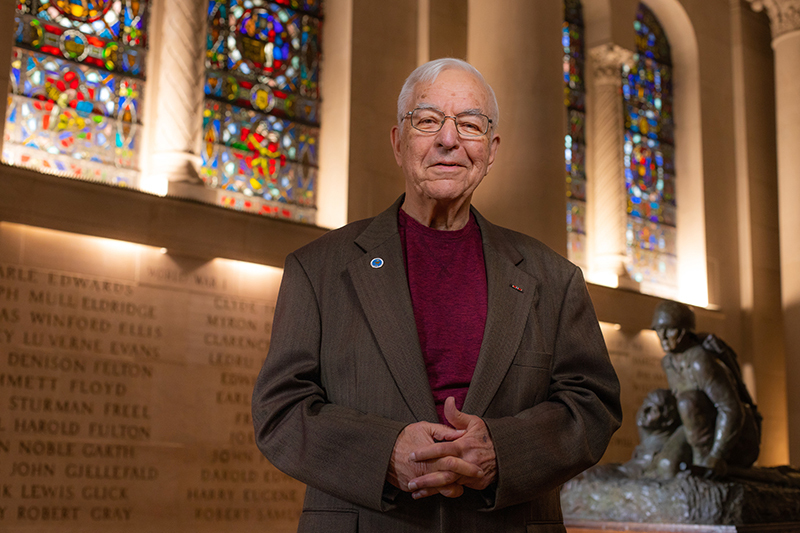
Vietnam veteran and Ames resident Jim Olberding in the Memorial Union's Gold Star Hall, the room he's helped share a more complete story. Photo by Christopher Gannon.
Fourteen names were engraved onto the World War II section of the Memorial Union's Gold Star Hall this year, thanks in large part to the tireless research of James Olberding.
Olberding, a Vietnam veteran who lives in Ames, is a member of the committee that oversees Gold Star Hall, a living monument to ISU students who made the ultimate sacrifice for their country. He helped to establish the Gold Star Hall committee in 2003 and played an instrumental role in starting the practice of yearly ceremonies to commemorate veterans listed in Gold Star Hall.
"I'd walk through Gold Star Hall and see names of people I went to school with," Olberding said. "I discovered by going to the Vietnam Veterans Memorial wall in Washington, D.C., that there were some people who had been missed."
Those missed names inspired Olberding to begin a years-long effort to make sure every ISU student who gave their life in an armed conflict receives their due recognition by inclusion in Gold Star Hall.
One might think that all the names of eligible WWII veterans would have surfaced in the nearly 80 years since the end of the conflict, but Olberding continues to find overlooked names in his quest.
Find them
The 14 World War II veterans added to Gold Star Hall in 2023:
- James Bernard Cavanagh, Pottawattamie County
- Charles Kenneth Follett, Union County
- Lewis John Fredericks, Franklin County
- James Fred Koch, Black Hawk County
- Robert Edward Koutsky, Linn County
- Frederick Eugene Lindgren, Woodbury County
- Lloyd Donald McNeil, Calhoun County
- Orlan George Middlen, Lyon County
- Thomas Dee Parsons, Jefferson County
- Jennings Marion Peterson, Polk County
- Walter John Ruchotzke, Cedar County
- Rodney A. Van Nimwegen, Sioux County
- Willard E. Ward, Wayne County
- John Homer Westburg Jr., Dallas County
To be eligible, someone must have attended Iowa State full time for one or more academic terms and died while in military service. Today, Gold Star Hall includes the names of around 600 students who served in World War I, World War II, Korea, Vietnam, Somalia, the USS Liberty, Iraq and Afghanistan. The university honors several veterans listed on the wall with an annual Gold Star Hall Ceremony, held earlier this week.
The 14-member Gold Star Hall Committee periodically hears from friends, roommates and family members of veterans they believe are eligible for inclusion on the wall but have been left off for various reasons. The committee researches each case to make sure the suggested veteran meets all the required criteria for inclusion. It's not uncommon for a name or two to be added in a given year, but this year's addition of 14 World War II veterans was an unusually large find, said Lana Seiler, an administrative assistant at the Memorial Union and a Gold Star Hall committee member.
"Gold Star Hall was intended to be a living memorial," Seiler said. "The efforts of Jim and the rest of the committee keep the memorial alive so that additional veterans who meet all the criteria -- past, present and future -- can have a place on the wall."
How he did it
Olberding's effort to uncover the 14 WWII names began several years ago when the De Moines Register published the names of numerous WWII veterans from across Iowa who died during the war. Olberding wrote the newspaper's editor to ask where that information came from, and the editor sent him a database from Ancestry.com. The database contained thousands of names of Iowans broken down by county. The list included military service numbers and rank, in addition to their names.
Olberding suspected this massive trove of information likely contained some names of veterans who had attended Iowa State and should be recognized in Gold Star Hall, so he and the Gold Star Hall committee collaborated with the registrar's office to check each name against enrollment records. Olberding's hunch turned out to be right, and the search resulted in the addition in August of 14 names to the World War II section of Gold Star Hall.
Olberding was born in Schenectady, New York, and spent much of his childhood in Ohio. But when it was time to go to college, he chose Iowa State due to strong family ties to the university. His father, aunt and three uncles graduated from Iowa State College, and his mother attended Iowa State for a time as well. He completed a bachelor's degree in history in 1963 before he was drafted into the U.S. Army. He spent two-and-a-half years in Vietnam and was awarded a battlefield commission on his first tour. He served in the Military Assistance Command, Vietnam, or MACV, a joint-service command established to provide advisory and assistance efforts to South Vietnam.
Committee founder
In 2003, he began putting the skills he learned as a history major at Iowa State to use by researching Iowa veterans. He sent a letter to then-president Gregory Geoffroy regarding the need for an ongoing process for evaluating and adding new names to Gold Star Hall. Thus was born the current committee and the annual ceremony.
But there's more work to be done, Olberding said. The database he cross referenced with ISU enrollment records contained only Iowa veterans. He believes there are still veterans from other states who attended Iowa State who are not yet on the wall. To find them, he said he'll go through old issues of the "Bomb," the former ISU yearbook, to find hometown information for students from out of state.
It's a painstaking and seemingly never-ending job, but Olberding said he plans to continue the research as long as he can.

